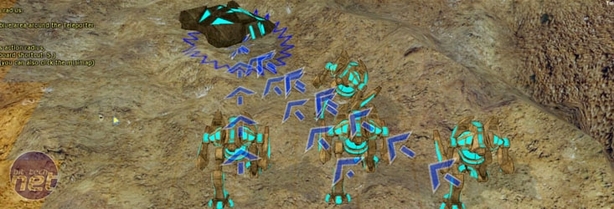
Achron Hands-on Preview
Publisher: IndependentPlatform: PC Exclusive
Release Date: 2010
Lately I’ve been playing the alpha version of Achron, the time-travel RTS, the same version that's being offered up to anybody who pre-orders the full game. It is, in brief and for those who don’t know, a strategy game which lets you and your opponents travel backwards and forwards in time at will, changing the outcome of past battles and dissolving your foes from the future.
If this is the first time you’ve heard about Achron then there are two questions which are inevitably going to pop into your head. They are; ‘How is that possible?’ and ‘Is it as complex as it sounds?’ and I’d be lying if I said I hadn’t laid awake most of last night thinking up ways to open this article and answer those questions as simply as possible – which is a damning comment on my social life, I suppose.
The answer I’ve come up with to both questions is ‘It’s complicated.’ From what I’ve seen of Achron the simple fact is that there’s no simple way to explain the game, especially when it’s currently only available in this pre-beta version that has none of the story, graphics or balancing of the final version (all being polished as we speak). Achron’s alpha is meant purely as a taste of the full game. It’s meant primarily as a proof of concept – a “look, the idea really does work” rather than a “this is what our game will be like”. I say that so you don’t rush to judge the game from the screenshots, because the graphics and UI aren’t supposed to be super polished in this build of the game.
So, how does time travel work? It’s easier to tackle this question in terms of the game mechanics rather than rushing to the most complex examples, I think. Yes, you can create paradoxes and go back in time to destroy units that have already attacked you in the future, but to understand all that you need to first get a grip on how the game treats the notion of time-travel. As lead designer Chris Hazard said when we interviewed him about Achron, “people often jump to the most complex scenarios and paradoxes…these complex scenarios aren’t typical in gameplay unless you purposefully cause them.”
Time travel in Achron is manifested a timeline chart at the bottom of the screen which, by clicking on it, you can jump to any point in the past or future of the game. A vertical line on the timeline tells you where every player is in time and a small chart keeps track of all game actions, such as damage dealt to your units. A glance at the timeline tells you where big battles have been fought and where you opponents have gone (in time) to try to influence their outcome.
Crucial to time travel is the idea of chronoenergy, the resource by which you can manipulate the timeline. Chronoenergy regenerates on it’s own, but the further you are in the past the slower it does so and the more energy you’ll need to do anything. In the future you need less and it regenerates fast, while giving orders in the present doesn’t require any at all. The system prevents you from just going to the very start of the timeline and killing the enemy then using and introduces a puzzle game element – how can you most effectively damage your enemy in the past with your limited resources?
The most important thing to understand about Achron though are the timewaves – regular updates to the timeline that can be seen sweeping across the game at intervals of 30 seconds. When a timewave moves through the game then it collects all the events it comes across and carries them forwards, altering the continuity as it goes. If you think it’s something that’s hard to get your head around then, well, join the club.

MSI MPG Velox 100R Chassis Review
October 14 2021 | 15:04











Want to comment? Please log in.